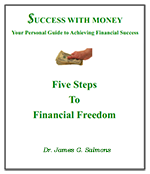It is one thing to say you want to get out of debt and another thing to do it. Debt elimination is an elusive goal for many, but it is certainly not impossible. In the face of today's economy many more people are waking up to the need to become debt free and succeeding at doing so. You can too.
The Challenge of Becoming Debt Free
Back during the Vietnam war days Pete Seeger wrote the classic war protest song Where Have All the Flowers Gone? The refrain was repeated over and over, “When will they ever learn? When will they ever learn?”
Focusing on the personal level (we don't want to get bogged down in national politics and government debt!), those words could equally speak to the puzzling relationship individuals have with debt. In war, everyone loses though perhaps in differing degrees. So with debt. But in neither case do we seem to learn.
In truth we learn less from the pains of debt than from those of war. No matter how much we suffer or how hard the struggle to get out of any particular debt most people seem driven to jump right back in at the first opportunity.
Note:
The benefits of living debt free are so fantastic it is amazing that everyone does not seek it with all the enthusiasm they can muster.
Yet the benefits of living debt free are so fantastic it is amazing that everyone does not seek it with all the enthusiasm they can muster. Eliminating debt is worth many times over the effort required to achieve it.
If you are reading this, let’s assume that you have decided to make a change in your own life. If so I can assure you that it is entirely possible to become debt free in a relatively short period of time if you want to, even if your debt is substantial.
This article is an introductory one for the series of articles I have written on eliminating debt. For the most part these steps need to be taken in the order presented. Each step builds on the ones before. Together they can help a person create a debt free life.
Step One:
How to Think About Debt
The human mind is a marvelous thing. It is capable of designing and manufacturing the most amazing devices: rocket ships for space travel, robotic devices for complex surgeries, the iphone and the wii. Unfortunatley, it is also capable of the most irrational thinking imaginable.
Nowhere is this more obvious than when we start thinking about money, and especially about debt. We are capable of rationalizing the most outreageous behavior. Given the opportunity we can actually turn debt into a virtue.
Note:
A cavalier attitude toward debt can destroy financial success more than any other factor.
The first step in the direction of debt elimination is totally mental. Personal debt must be recognized for what it is, one of our worst enemies. A cavalier attitude toward debt can destroy financial success more than any other factor.
An important component of a more productive attitude is the ability to visualize the benefits of becoming debt free. But equally or perhaps more important is to realize its practicality.
When your mind is set in the right direction, financial freedom lies ahead. I will discuss how you can experience it in my article, How to Think About Debt.
Step Two:
Learn to Live on Less than You Make
All too often I find myself saying, “How obvious can it get?” This is another of those cases. But no matter how obvious it may seem, if most people are not doing something it must not appear to be the obvious thing to do for a lot of folks.
This is where the chronological sequence of these steps come into play. Only after a person has developed a mind set that recognizes the practicality of living debt free are they capable of making the kind of firm commitment to debt elimination that makes it possible.
You can probably eliminate your debts in a reasonably short period of time without any additional money than what you are now spending on credit card and loan payments. But you must learn how to stop spending more than you earn. And you must stop creating new debts. It is as simple as that.
Fortunately this is not as difficult as it may seem. You will probably only need to reduce spending a few dollars a month. In Learn to Live on Less than You Make you will see how this can be done by anyone who really wants to do so.
Step Three:
Work Out Your Debt Payoff Plan
This is probably the easiest part to understand. Nevertheless, it does call for making some decisions that are challenging for some people. This is because there are many variables that may call for different choices for people even in similar circumstances.
Note:
To start, while you adjust to your new spending plan, it is usually best to continue applying only the same amount you are now spending on debt payments.
After making some progress you may want to increase the amount you spend each month to pay off your debts. But to start, while you adjust to your new spending plan, it is usually best to continue applying only the same amount you are now spending on debt payments.
But you want to continue spending the same total amount each month. When required payments on an individual credit card goes down, for example, you will continue paying the same amount you are paying now.
If you are spending $325 each month on credit card debt and $265 on a car payment, for a total of $590 now, you will continue to allocate that $590 each month toward debt reduction every month. When you pay off one debt you will just apply that amount to the others.
In the article, Make Your Personal Debt Payoff Plan, you will learn a lot more about how you can most effectively structure your payoff plan.
Step Four:
Debt and Your Overall Financial Plan
Some years ago I heard someone suggest a list of things a person cannot do. One was mental. It proposed that you cannot stand on a street corner for fifteen minutes and not think about a white elephant.
In some ways getting out of debt is something we cannot do without thinking about our overall financial goals and plans.
Now the only reason you cannot avoid thinking about the white elephant is because the idea has been placed in your mind. But in the case of our money there is an unavoidable intertwining of extremely important life issues.
When we owe a lot of money:
- All of our income goes to living expenses and debt payments.
- We neglect proper funding of retirement accounts.
- We have to give up or downgrade vacations.
- We stay in jobs we hate.
When we are debt free we can easily fund these things and much more. When we really understand how our debts are keeping us from experiencing some of the most valuable opportunities of life we will find it much easier to avoid taking on unnecessary debt in the future.
This whole theme is developed fully in my article, Debt and Your Overall Financial Plan. Some related topics are discussed there, too, such as when if ever investing is better than paying off debt.
Step Five:
Maintain the Drive to Live Debt Free
Ever see a double humped camel? Well there are two “humps” to get over in your debt elimination program.
In truth, the most critical part comes before either of them. It is getting started. Very few people ever make a sincere effort to get in control of their money and get rid of debt in the first place.
When you have followed the first four steps above and set out on the journey, you have done the hardest part. But there are two points ahead where the going gets tough and a lot of people revert to old habits.
The first hump. The first challenging time comes after several months, perhaps even a couple of years when most people will experience the feeling that they are getting nowhere fast—or really just a short distance slowly.
Note:
Once momentum sets in it really accelerates and it becomes exciting to watch debts quickly disappear.
But don’t get discouraged. The reality is that progress seems very slow for some time. But once momentum sets in it really accelerates and it becomes exciting to watch debts quickly disappear.
The second hump. The second challenging time comes after all personal debts, at least credit card debts, are paid off. It is easy to get a cocky feeling that it wasn’t all that hard to pay off all that debt after all. The guard goes down and pretty soon an even larger amount of debt is acquired.
Once your debts are paid off and you have a little while to experience the great freedom of being debt free, once you experience the great joy of being able to do the things you really want to do in life, once you have the peace of seeing your retirement investments starting to assure a positive future, you will never consider going back. But you must get to that point first.
In the fifth and final article in this series, Maintaining Drive and Enthusiasm, you will learn how to keep the fires alive during the difficult times and keep on course toward becoming and staying debt free.
Conclusion
Becoming debt free is not an end in itself, it is a means to an end. Debt is one of the most debilitating forces in life. Being debt free is one of the most liberating.
If a person is serious about their financial goals, getting rid of personal debt is an absolute must. It is not the end, but part of the beginning. Once this is achieved, everything else seems easy.
If you follow the steps outlined here you can find the same success that others have. These are proven principles and they work. Good success.










